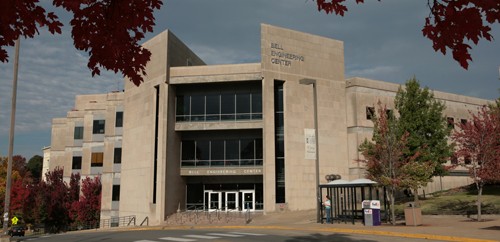In January of 1987, the students, faculty and staff of the College of Engineering began the spring semester in a brand new building: Bell Engineering Center. The new building provided designated space for four of the college’s departments–chemical engineering, civil engineering, electrical engineering and industrial engineering—as well as plenty of room for classrooms and teaching labs, and these changes proved to be revolutionary for the college.
Before Bell
“Before Bell, the situation was very grim,” remembered Neil Schmitt, who was dean at the time of the move. “We had four departments in Engineering Hall. There was no space for expansion, no room for research, no lab facilities. Everybody realized we had to do something.”
Ed Clausen, professor of chemical engineering remembers the “holding pen,” one large room in Engineering Hall that functioned as an office for all of the college’s graduate students. There were over 80 graduate students, and “they all supposedly had a desk in that room,” said Clausen.
When Bell was finished, Engineering Hall was also renovated. At the same time, new research labs were being created at the Engineering Research Center (which was then called Engineering South). “Having new instructional and lab facilities and having new research facilities really propelled the College of Engineering from a small teaching college into a nationally competitive college,” said Schmitt.
Built to Last
It was James Halligan, the dean before Schmitt, who got preliminary approval from the university to create a new building in 1981. “Over that weekend, he went out and had people dig the hole,” said Clausen, and this hole was the only evidence of what was to come for several years, until Schmitt finally secured the funding to begin construction in 1984.
In addition to the state funds used for construction, the college also needed money for teaching and lab equipment. Most of these funds came from Melvyn L. Bell, a College of Engineering alumnus who named the building in honor of his mother and father, Owen and Hildur. At the building’s dedication, Bell stated, “My hope is that future generations will not only benefit from this gift but perceive it as a symbol of the virtues for which my parents stood and the love we shared as a family.”
Designed by the architecture firm Polk, Stanley and Gray, Bell was intended to be architecturally pleasing as well as suit the specific needs of the college. “The first time I walked in, I was amazed,” remembered Schmitt. “It’s true that the architecture is insightful. Coming from where we were, it was a striking contrast.”
Schmitt explained that the college worked closely with the architects to make sure each of the four departments housed in Bell had their own designated space, with faculty offices set apart in interior hallways to cut down on noise. Four study areas, one for each department, were included at either end of the building to give students a place to gather and work.
The most notable feature of Bell Engineering is the large ramp that runs north and south, from one corner of the building to the other. Schmitt explained that the ramp is on the site of an old road, Campus Drive, which was one of the main arteries on campus.
When the college got permission to put a building on top of this road, they agreed to maintain a direct entrance to campus, and this agreement is the reason for the ramp, which gives easy access from Dickson Street to the heart of campus. Today, Campus Drive is no longer a feature of the campus, and the ramp inside Bell the only evidence of its path.
Another innovative feature of the building was the easy access provided for wiring and other infrastructure. Schmitt explained that the wiring is in the hallway ceiling so that it is easy to repair and upgrade. All the labs are connected through central chases, space between the walls that can be easily accessed to put in new infrastructure, such as compressed air.
“The design has proven to be very functional and very efficient,” said Schmitt. “Bell is a striking building today and will be 50 years from now.”
A Different Time
In the early eighties, when the College of Engineering was working with the architects to design Bell, faculty members did not routinely have computers in their offices. By the time the new building opened, however, times had changed and the college had to make sure faculty and students had access to this new technology. A large space on the first floor (where the Welcome Center is now) was designated as a student computer lab.
The college has gone through several other changes since Bell was first built. In 1983, Schmitt remembers, only around 14% of engineering students were female, and “we may have had one female faculty member.” Schmitt is glad to see that, along with the rest of the nation, the College of Engineering has been steadily increasing these numbers. “Having women faculty role models is very important,” he said.
This time period also marked a change in the College of Engineering’s relationship to its alumni and other supporters. As part of the agreement for the new building, Schmitt was asked to raise $1 million for the labs in the building. As far as he knew, no one at the university had ever raised this much money for a single project, but the College of Engineering far exceeded this goal, raising $12 million.
Schmitt credits Susan Vanneman, the college’s director of the development at the time, with reaching out to engineering alumni. “Our alumni said ‘no one every asked us,’” explained Schmitt. “They were very generous.”
Around this time, the Academies, elite groups of College of Engineering graduates, were being established, and these organizations also helped raise funds for the new building, as well as strengthening ties between the college and its alumni.
Bell Engineering Center has held up well over the years, proving itself to be adaptable to the academic and technological needs of students and faculty. Today the building is one of the most remarkable on campus, and it is the building most closely associated with the College of Engineering.
In addition to spaces for learning, research and studying, Schmitt mentioned one more feature of Bell that students found useful. As they passed the statue of the Bells in the front entrance, students would rub Owen Bell’s head for luck. “It got very shiny,” he said.


